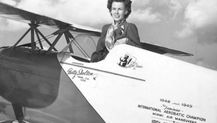Pitts Special S-2B N9QT
After many years of dreaming, a lot of training, and negotiations with a very supportive spouse, I am the proud pilot of 1997 Pitts Special aerobatic biplane, tail number N9QT.
N9QT was produced at the Aviat Aircraft factory in Afton Wyoming in 1996, marking 50 years since Curtiss Pitts started selling the first Pitts Specials, right after the second world war. N9QT is one of two 50th anniversary edition Pitts with a special, one-of-a-kind paint-job, a 50th anniversary decal, and a bronze plaque behind the pilot's head that was signed by the legend himself, Curtiss Pitts.

The Pitts Special was one of the first aircraft designed specifically for flying aerobatics. World-famous airshow pilot Betty Skelton was one of the first people to have a Pitts type "S1" built for her in the late 1940s, which she nicknamed "Little Stinker" after the skunk cartoon Curtiss had painted on the early models:
Betty's Pitts S-1 is currently on display at the Smithsonian Air and Space Museum. You can read more about this amazing aviator at the IAC website.
After much success of the Pitts Special S-1 series in aerobatic competitions all over the world, Curtiss saw the need for a two-seat, certified version designed to train aerobatic pilots and competitors. The Pitts S-2 series were first certified with the S-2A in the early 1970s. The S-2A is a 4-cylinder design making 160 horsepower. This was followed by the S-2B and S-2C two-seaters, both featuring the Lycoming AEIO-540, 6-cylinder, 260 horsepower engine. These more powerful models are spectacular in their climb performance, with more horsepower per pound than a P-51D Mustang.
Here are some photos of N9QT and some of its happy occupants:

Pitts are known for their impeccable handling in the air. The controls are perfectly balanced and harmonized requiring only the tiniest amount of stick or rudder deflection for maneuvering the aircraft. This quality lends the airplane an almost subconscious "mind-meld" effect; the pilot merely has to think about which direction to point it, and the airplane will dutifully take the hint. The extreme sensitivity of the controls takes some getting used to, and Pitts airplanes have a reputation for exposing a pilot's most subtle bad habits.
For all its lovely qualities in the air, trying to get a Pitts back on the ground is legendarily challenging. Three factors contribute to the excitement factor when trying to land one of these amazing airplanes:
-
You cannot see the runway when lined-up on final approach because of the huge nose.
-
The Pitts has a glide-ratio similar to a manhole cover, meaning final approach speeds are very high for such a small, light airplane (about 100mph for the S-2B).
-
The airplane's extreme control sensitivity and short fuselage make it intolerant of landings that are not perfectly straight.
Budd "Airbum" Davisson has been teaching people to land Pitts airplanes for decades at his Scottsdale, AZ Pitts flight school.
I regularly teach basic aerobatics and spins (upright and inverted) in N9QT. If you're interested in getting some stick time in one of the most famous airplanes ever designed, check out my flight training website - www.orion-aero.com.
Thanks for reading!
Hogarth "Hoagy" de la Plante
Oakland, California, 2022


















